Introduction
In a fast-paced world where convenience often outweighs quality, there’s something deeply rewarding about stepping into your backyard or balcony and harvesting fresh, vibrant vegetables you’ve grown yourself. Homegrown vegetables are more than just a trend—they’re a step towards healthier living, sustainability, and reconnecting with nature. When you grow your own food, you’re in control of what goes into your soil and onto your plate. You can avoid harmful chemicals, reduce your carbon footprint by cutting down on transport and packaging, and enjoy superior taste and nutrition compared to store-bought produce.
For beginners, vegetable gardening offers an accessible and highly satisfying way to start this journey. You don’t need vast acres of land or years of experience. Even a few pots on a windowsill can yield fresh herbs and greens. Gardening not only provides fresh food but also reduces stress, improves mental health, and encourages physical activity. It’s a hobby that gives back in abundance, from crunchy carrots and juicy tomatoes to a sense of accomplishment and peace.
This guide is designed to help beginners confidently take their first steps into vegetable gardening. We’ll cover everything from choosing the right vegetables for your space and climate, to understanding soil, sunlight, and watering needs. You’ll also find practical tips for dealing with common challenges like pests and weather changes. Whether you dream of a thriving backyard garden or a small indoor setup, this guide will give you the knowledge and motivation to start growing your own food—and reaping the many rewards that come with it.
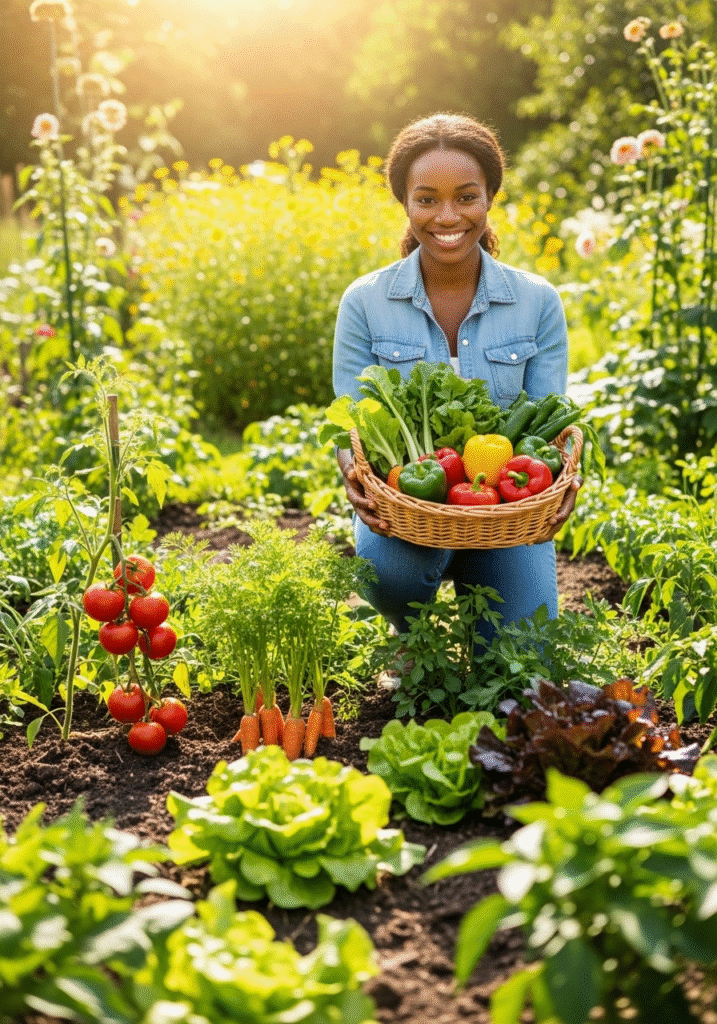
Why Start a Vegetable Garden?
There’s a unique satisfaction in stepping outside and picking fresh vegetables you’ve grown with your own hands. One of the most compelling reasons to start a vegetable garden is the access to fresh, organic produce. Store-bought vegetables often travel long distances before reaching your plate, losing both flavor and nutrients along the way. When you grow your own, you can harvest at the peak of ripeness, enjoying vibrant colors, unmatched taste, and higher nutritional value. Plus, you have full control over what goes into your garden—no harmful pesticides, no chemical fertilizers—just wholesome, organic food for you and your family.
Starting a vegetable garden is also a smart move for your wallet and the planet. Growing even a small portion of your own produce can lead to significant cost savings over time, especially as grocery prices continue to rise. Beyond financial benefits, home gardening reduces your carbon footprint. By cutting out the need for transport, packaging, and refrigeration, you’re making a sustainable choice that supports the environment. Composting kitchen scraps and using eco-friendly gardening practices further enhance your garden’s role in a more sustainable lifestyle.
But the benefits of a vegetable garden go far beyond food and finances. Gardening is a rewarding outdoor hobby that nurtures both body and mind. It encourages you to spend time in the fresh air, soak up vitamin D, and engage in physical activity like digging, planting, and harvesting—all of which promote better physical health. At the same time, tending to plants has been shown to reduce stress, boost mood, and provide a sense of accomplishment. It’s an enjoyable, therapeutic escape from daily routines that leaves you feeling more connected to nature.
Whether you’re driven by the desire for fresher food, a more sustainable lifestyle, or a healthier mind and body, starting a vegetable garden offers an abundance of benefits. It’s a simple yet powerful step toward a more rewarding way of living.
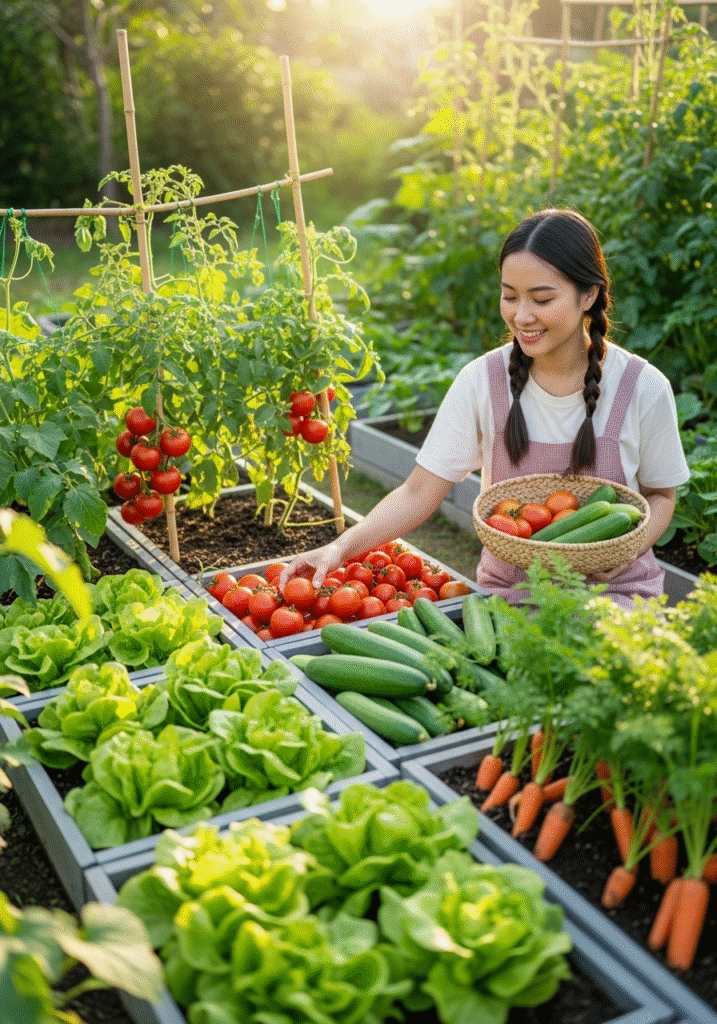
Choosing the Right Location
The success of your vegetable garden begins with choosing the right location. Plants are living things that depend on their environment to flourish, and understanding what they need will save you time, effort, and disappointment later.
First and foremost, consider sunlight. Most vegetables—especially fruiting varieties like tomatoes, peppers, cucumbers, and squash—thrive when they receive 6 to 8 hours of direct sunlight each day. Leafy greens such as lettuce, spinach, and kale can tolerate partial shade, but even they perform best with generous light. Take time to observe your yard, balcony, or windowsills to identify areas that receive consistent sunlight throughout the day. Keep in mind that sunlight patterns change with the seasons, so try to plan for year-round exposure if possible.
Next, assess your soil. Healthy soil is the foundation of any productive garden. Look for areas with well-draining soil; waterlogged ground can suffocate roots and lead to rot or disease. You can test drainage by digging a small hole, filling it with water, and seeing how long it takes to drain—ideally, within a few hours. In addition to drainage, check the soil’s texture and fertility. Rich, loamy soil with a balanced mix of sand, silt, and clay provides the best environment for most vegetables. If your soil is poor or compacted, consider raised beds or container gardening, where you can control the soil quality more easily.
Space is another key factor. You don’t need a large plot to start growing your own food. For those with limited outdoor areas, small spaces like patios, balconies, or even sunny windowsills can support container gardens filled with herbs, salad greens, or dwarf vegetable varieties. For larger yards, you can plan rows or raised beds to maximize your harvest. Think about accessibility as well—choose a location that’s convenient for watering, weeding, and harvesting. A garden you can see and reach easily is more likely to be cared for consistently.
By thoughtfully selecting the location for your vegetable garden, you set your plants up for success and create a space that’s not only productive but also a pleasure to tend.
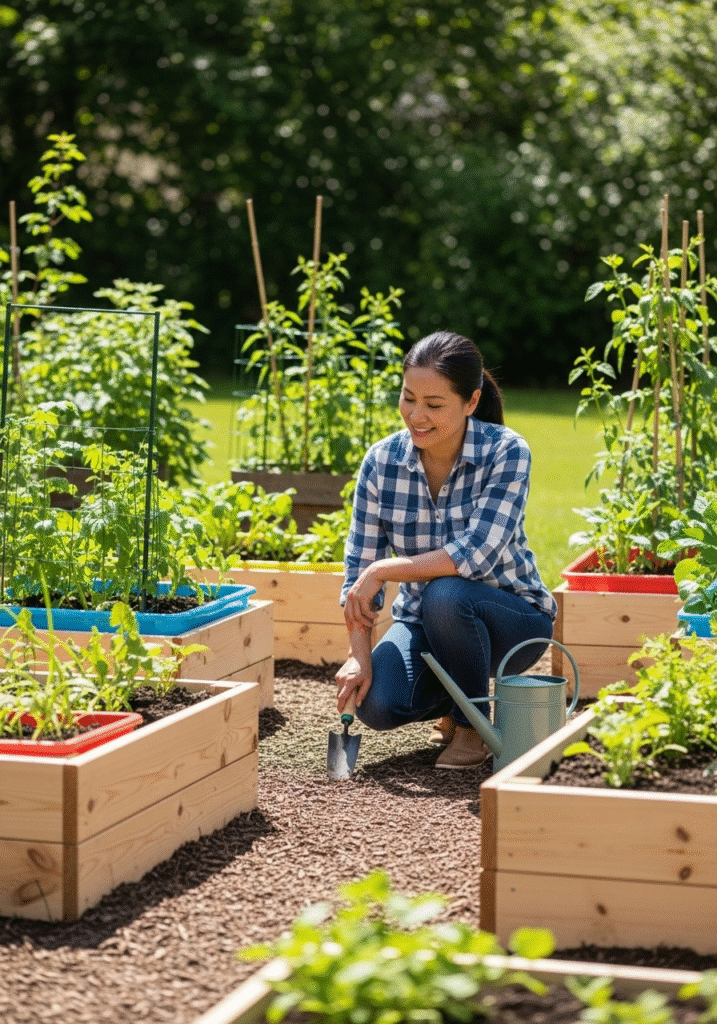
Essential Tools and Supplies for Beginners
Starting a vegetable garden doesn’t require a shed full of fancy equipment, but having a few essential tools and supplies on hand will make the process smoother, more enjoyable, and more successful. Think of it as assembling your beginner’s gardening toolkit—just the basics to get you started without overwhelming you.
Start with the right tools. A good pair of gardening gloves is a must to protect your hands from thorns, splinters, and soil-borne irritants. A trowel (a small hand-held shovel) will be your go-to tool for digging holes, planting seedlings, and transplanting. A watering can or a hose with a gentle spray attachment ensures your plants get the hydration they need without washing away delicate soil or seeds. For larger gardens, a hoe or hand fork can help with loosening soil and removing weeds. These few items are enough to handle most tasks in a beginner’s garden.
Don’t forget about your soil. Quality soil is the foundation of a thriving garden. If you’re planting in the ground, enrich your native soil with compost or well-rotted organic matter to improve fertility, structure, and drainage. For raised beds or containers, use a high-quality potting mix designed for vegetables. Compost is a gardener’s best friend, adding essential nutrients and improving water retention while encouraging healthy root development.
Seeds or seedlings? Beginners often wonder whether to start from seeds or purchase young plants (seedlings) from a nursery. Starting from seeds is rewarding and cost-effective, especially for easy crops like lettuce, radishes, and beans. However, it requires more time, attention, and the right conditions for germination. Seedlings, on the other hand, give you a head start. They’re ideal for longer-season crops like tomatoes, peppers, and eggplants, where starting from seed can be challenging without a greenhouse. For most beginners, a mix of both is a great approach—try direct-seeding quick growers while buying seedlings for slower, more delicate vegetables.
By equipping yourself with these simple tools and supplies, you’ll be ready to dive into vegetable gardening with confidence. As your skills grow, you can gradually add more specialized tools, but at the start, keep it simple and focus on learning the rhythms of your garden.
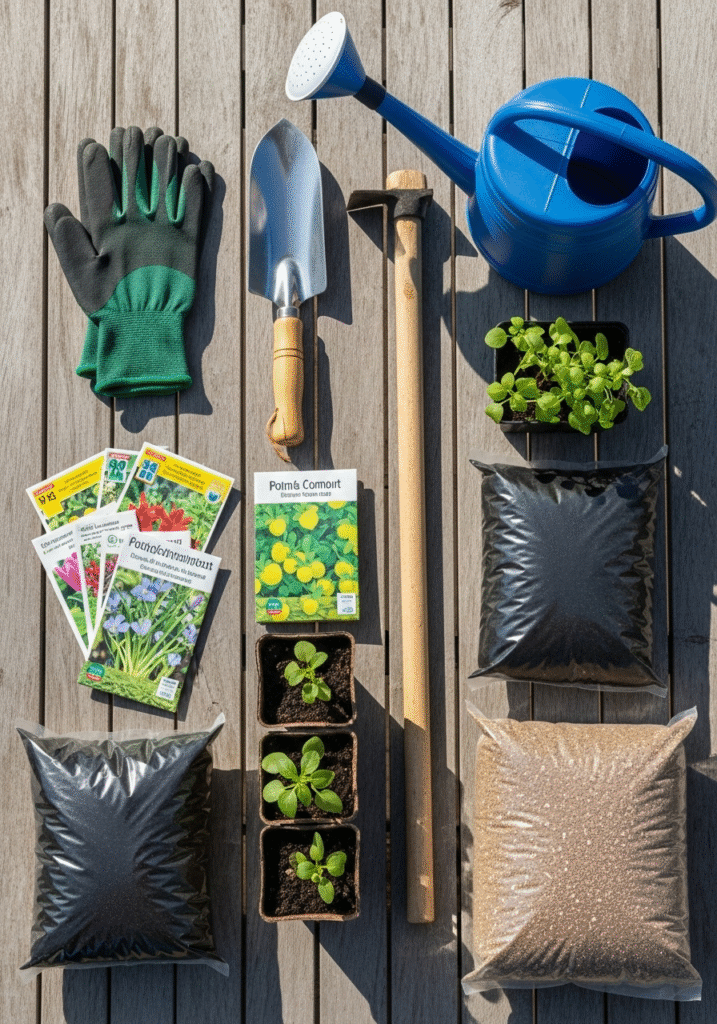
Preparing the Soil for Planting
A thriving vegetable garden begins beneath your feet—with healthy, nutrient-rich soil. Preparing your soil properly is one of the most important steps in gardening, as it directly affects your plants’ growth, yield, and resilience. Whether you’re planting in the ground, raised beds, or containers, investing time in soil preparation will pay off in healthier, more productive crops.
Start by testing and improving soil quality. Before planting, get to know your soil’s current condition. Is it sandy, clay-heavy, or loamy? Does it drain well, or stay soggy after rain? You can do a simple test at home by squeezing a handful of moist soil—if it crumbles easily, it’s likely loamy and ideal for vegetables. For a more detailed analysis, consider using a basic soil testing kit to check pH levels and nutrient content. Most vegetables prefer slightly acidic to neutral soil (pH 6.0–7.0). If your soil is too acidic, adding lime can help. If it’s too alkaline, sulfur or peat moss may bring it closer to the desired range.
Enrich the soil with compost and organic fertilizers. Once you’ve assessed your soil, it’s time to improve it. Adding compost is one of the easiest and most effective ways to boost soil fertility and structure. Compost provides essential nutrients, encourages beneficial microorganisms, and helps retain moisture while improving drainage. If compost isn’t available, well-rotted manure, organic fertilizers, or a mix of both can also enhance the soil. Gently work these amendments into the top 6–8 inches of soil using a garden fork or hoe, being careful not to disturb deeper layers unnecessarily.
Consider raised beds or containers for better control. If your native soil is poor, compacted, or contaminated—or if you’re working with limited space—raised beds or containers can be excellent alternatives. Raised beds allow you to fill them with high-quality soil and compost, giving your plants an optimal growing environment from the start. They also improve drainage and reduce soil compaction. Containers are perfect for patios, balconies, or small spaces, and they’re highly versatile. Just ensure they have good drainage holes and are large enough for the vegetables you plan to grow.
By taking these steps to prepare your soil, you’re giving your garden the best possible start. Healthy soil means stronger plants, fewer pests and diseases, and more bountiful harvests. Think of it as building a strong foundation—once in place, everything else becomes easier.
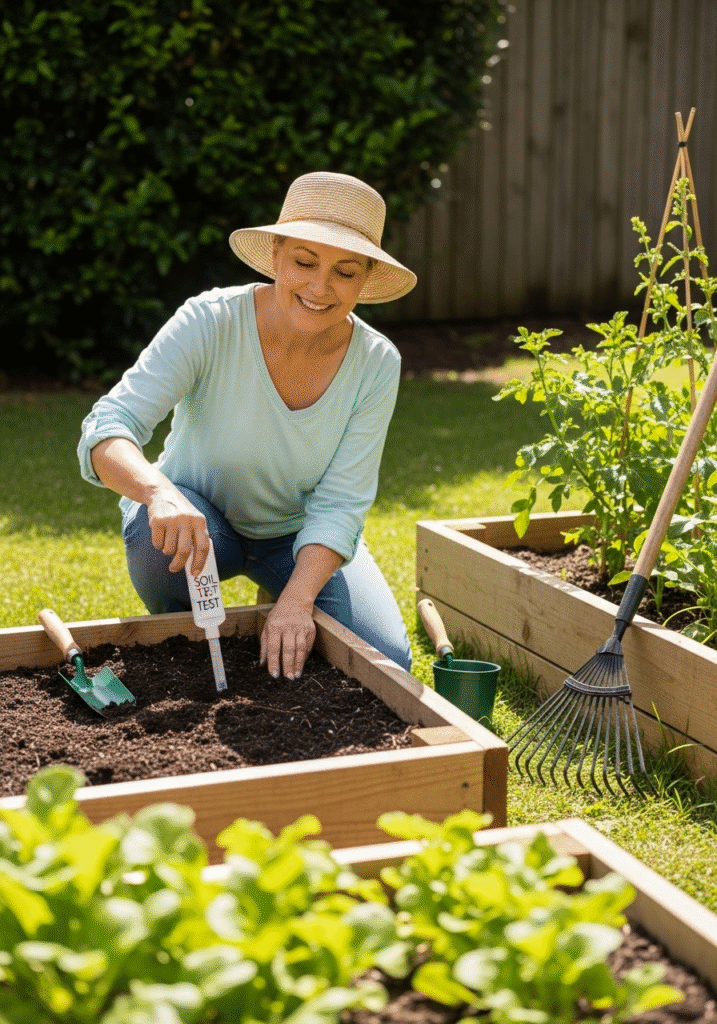
Best Vegetables for Beginners
When you’re just beginning your vegetable gardening journey, it’s helpful to start with crops that are easy to grow, require minimal maintenance, and offer quick rewards. Luckily, there are plenty of vegetables that fit these criteria, and many of them are perfect for new gardeners. Whether you’re working with a small balcony garden, a raised bed, or a traditional backyard plot, here’s a list of the best vegetables to try, along with their ideal planting seasons to help you plan.
Tomatoes:
Tomatoes are a classic garden favorite and surprisingly easy to grow, even for beginners. They thrive in sunny spots with 6–8 hours of direct sunlight and can be grown in the ground, raised beds, or containers. Start seeds indoors 6–8 weeks before the last frost date or purchase seedlings for a head start. They’re warm-weather plants, so plant them outside after the risk of frost has passed, usually in late spring or early summer. Tomatoes typically take 50–90 days to mature, depending on the variety, but their reward is worth the wait—fresh, juicy, homegrown tomatoes that taste far better than store-bought ones.
Lettuce:
Lettuce is one of the quickest and easiest vegetables to grow, making it a perfect choice for beginners. It’s a cool-season crop that grows well in spring or fall, ideally in temperatures between 45°F and 75°F (7–24°C). You can sow lettuce seeds directly into the garden or plant them in containers. It takes just 30–60 days from seed to harvest, and you can enjoy multiple harvests by cutting outer leaves while letting the center grow back. Lettuce loves partial shade, making it ideal for smaller spaces or areas with limited sun.
Radishes:
Radishes are incredibly fast-growing and one of the most forgiving crops you can plant. They germinate quickly (usually within 3-7 days) and are ready to harvest in just 3–4 weeks. Radishes grow best in cool weather, so they’re perfect for planting in early spring or late summer, before or after the hot summer months. Plant them directly in the soil, and you’ll see their bright red bulbs emerge in no time. Radishes don’t need a lot of space, making them ideal for small gardens or container planting.
Carrots:
Carrots are another fantastic choice for beginners. They’re versatile, easy to grow, and can be planted in the ground or raised beds. Carrots do best in loose, well-drained soil, and they prefer cool temperatures. Plant them in early spring or late summer to avoid the heat of high summer. Carrots take a bit longer to mature than radishes or lettuce, typically 70–80 days, but they’re well worth the wait. Be patient and keep the soil consistently moist during the growing season, and you’ll soon be pulling out sweet, crisp carrots from your garden.
Spinach:
Spinach is a highly nutritious, fast-growing leafy green that thrives in cooler temperatures. It’s ideal for early spring or late fall planting when the weather is mild. Spinach can tolerate light frost, so it’s one of the first vegetables you can plant in spring. You can start spinach directly from seeds, and it usually takes 30–45 days to harvest. Spinach does well in partial shade, making it a great choice for small or shaded areas. Plus, it’s versatile in the kitchen—use it in salads, smoothies, or sautéed as a side dish.
Zucchini:
Zucchini is a prolific, easy-to-grow vegetable that’s perfect for beginners with a bit more space. These plants love full sun and warm soil, so wait until all danger of frost has passed to plant them, typically in late spring. Zucchini grows quickly, and you’ll usually start seeing fruit in about 50–60 days. One zucchini plant can produce a surprising amount of fruit, and because they grow so well in both garden beds and containers, they’re ideal for most spaces. Just be sure to give them plenty of room to spread out, as they can become quite large!
Planting Seasons and Tips:
Each vegetable listed here has its own ideal planting window, but most of them thrive in the spring and early summer. Here’s a quick summary of when to plant:
- Tomatoes: Plant after the last frost in late spring or early summer.
- Lettuce: Best planted in early spring or fall for cooler temperatures.
- Radishes: Plant in early spring or late summer for cooler weather.
- Carrots: Early spring or late summer—plant when the weather is cool.
- Spinach: Ideal for early spring or fall, preferring cooler weather.
- Zucchini: Wait for late spring after the risk of frost has passed.
By starting with these easy-to-grow vegetables, you’ll quickly build your confidence as a gardener and experience the joy of growing your own food. Whether you’re looking for quick harvests like radishes or a long-growing favorite like tomatoes, there’s something here for everyone, no matter how much space or experience you have.
To keep your indoor air fresh and healthy, discover the Top 10 Air Purifying Plants that are both beautiful and beneficial.
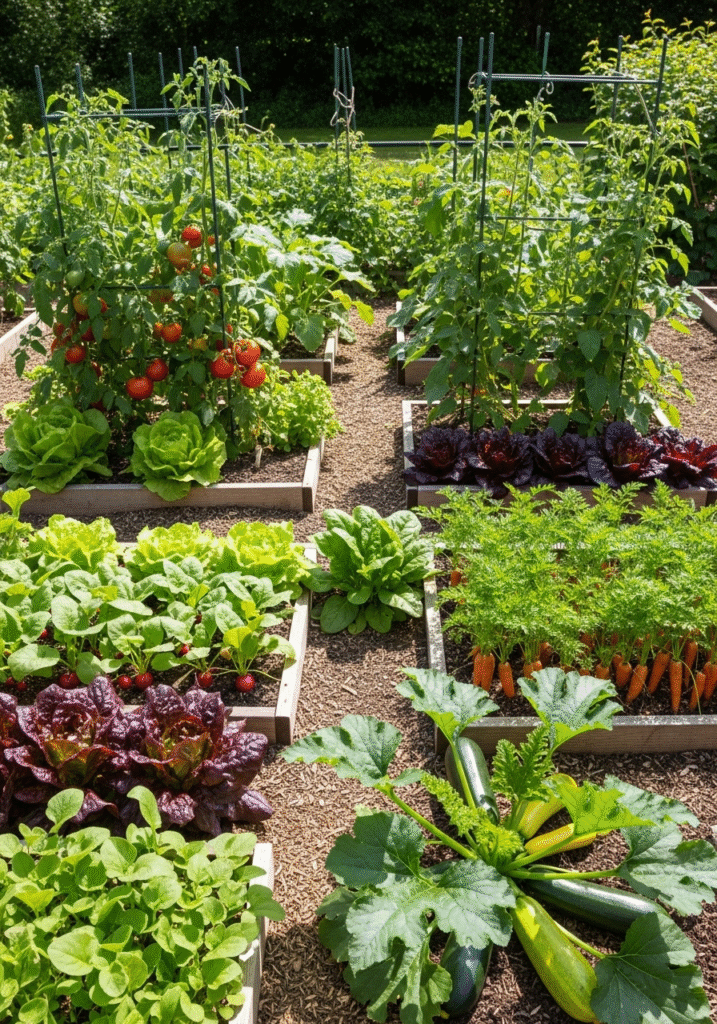
Step-by-Step Planting Guide
Starting with seeds gives you the chance to see your plants grow from scratch, and it’s incredibly rewarding. Here’s how to begin:
- Prepare the Soil: Ensure the soil is loose, well-draining, and rich in nutrients. If you’re planting directly into the ground, loosen the soil with a garden fork or rake to create a good environment for your seeds to germinate. If you’re using containers, fill them with a high-quality, well-draining potting mix.
- Read the Seed Packet: Each packet of seeds provides vital information, including when to plant, how deep to plant, and how far apart to space your seeds. Be sure to follow the guidelines on the packet, as these are tailored to the specific variety you’re growing.
- Planting Depth: The general rule of thumb is to plant seeds at a depth that is about 2-3 times the size of the seed. For tiny seeds like lettuce or radishes, just cover them with a thin layer of soil. Larger seeds, like beans or peas, need to be planted deeper (around 1–2 inches).
- Sow Seeds Evenly: Use your fingers, a small hand rake, or a planting tool to scatter the seeds evenly in the planting area or container. For larger seeds, make small holes in the soil at the appropriate depth and place a seed in each hole.
- Cover the Seeds: Gently cover the seeds with soil, pressing lightly to eliminate air pockets but avoid compacting it too much. After planting, water gently to help settle the soil around the seeds.
2. Spacing and Depth for Different Vegetables
Proper spacing is crucial to ensure your plants have enough room to grow and access sunlight and nutrients. Here’s an overview of how much space each vegetable typically needs:
- Tomatoes: Space tomato plants about 18–24 inches apart in rows that are 3–4 feet apart. Tomatoes need room to spread and a sturdy structure to grow tall, like stakes or cages.
- Lettuce: Lettuce varieties generally require 6–12 inches between plants depending on the type. Space them further apart for larger varieties and closer for smaller “baby” lettuces.
- Radishes: These small, quick-growing vegetables only need 1-2 inches between seeds. Rows should be spaced about 6–8 inches apart.
- Carrots: Carrots need 2–3 inches between seeds and 12–18 inches between rows. Thinning them out once they germinate will help avoid overcrowding.
- Spinach: Space spinach seeds about 1 inch apart and thin to 4–6 inches when they start growing. Rows should be 12 inches apart.
- Zucchini: Zucchini needs plenty of room. Plant seeds 2–3 feet apart in rows that are 4–6 feet apart. These plants spread wide and need space to grow.
3. Watering and Sunlight Tips
Once your seeds are planted, maintaining the right watering and sunlight conditions is crucial to getting your garden off to a strong start.
- Watering:
- Keep the Soil Moist, Not Soaked: Newly planted seeds need consistent moisture to germinate, but avoid overwatering, as soggy soil can cause seeds to rot. After planting, water gently with a fine spray, keeping the soil evenly moist but not drenched.
- Water Early in the Day: Water your garden in the morning when the air is cooler. This helps prevent fungal growth and ensures that your plants have enough moisture to carry them through the day.
- Deep Watering: Once your seedlings have emerged and are growing strong, water deeply to encourage deep root growth. Shallow watering can lead to weak roots and stressed plants.
- Sunlight:
- Follow Sunlight Needs: Most vegetables need 6-8 hours of direct sunlight per day, but some—like lettuce and spinach—can tolerate partial shade. Make sure to place your plants in a spot where they will receive their recommended amount of light, whether in a full-sun garden, a sunny balcony, or under a grow light if you’re growing indoors.
- Adjust for Seasons: The sun’s position in the sky changes throughout the year. If possible, try to plant where the area gets full sunlight during the growing season. For fall and early spring crops, light might be a bit more limited, so plan for plants that can thrive in cooler, less sunny conditions.
4. After Planting Care
After sowing your seeds and giving them the right care, you’ll need to stay on top of a few other tasks to ensure successful growth:
- Thin Out Seedlings: Once your seedlings emerge, you may need to thin them out to prevent overcrowding. For example, if you’ve planted radishes or carrots, remove weaker or extra seedlings so that the remaining plants have enough space to grow.
- Mulching: Adding a thin layer of mulch around your plants helps retain moisture, suppress weeds, and regulate soil temperature. This is especially helpful for crops like tomatoes, zucchinis, and lettuce.
- Watch for Pests: Keep an eye out for pests that may target your young seedlings. Insecticidal soap or natural remedies like neem oil can help protect your plants.
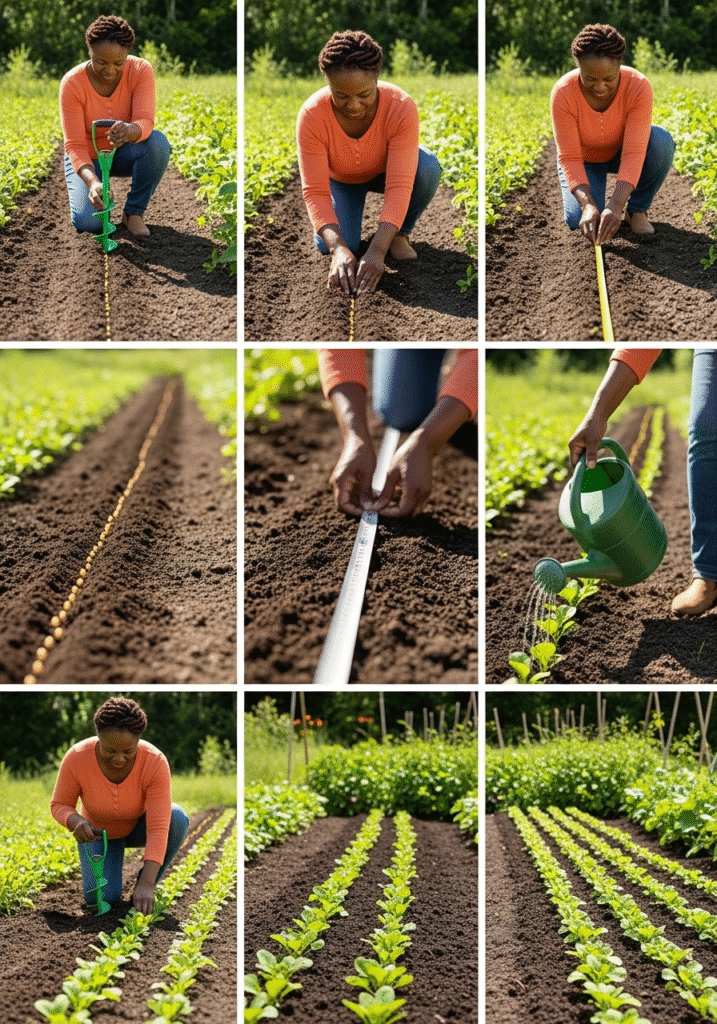
Caring for Your Vegetable Garden
Caring for Your Vegetable Garden: Tips for Healthy Growth and a Bountiful Harvest
Once your vegetable garden is planted, the real work begins! Maintaining healthy plants requires regular attention, but with the right practices, you’ll enjoy a flourishing garden and a rewarding harvest. Proper care ensures your plants grow strong, resist disease, and provide you with fresh, homegrown vegetables. Let’s dive into the key areas of care: watering, pest management, weeding, mulching, pruning, and harvesting.
1. Watering Schedules
Watering is essential for healthy plant growth, but how much and how often you water depends on several factors, including the weather, soil type, and the specific needs of your vegetables. Here are a few watering tips to keep in mind:
- Water Deeply, Not Frequently: Vegetables thrive with deep watering that encourages strong root growth. Aim to water deeply a few times a week (2–3 times) rather than lightly watering every day. This will help your plants develop deep roots that are more drought-tolerant.
- Morning is Best: Water your garden early in the day, before the heat of the sun causes excessive evaporation. Watering in the morning gives plants time to absorb moisture, and it helps prevent diseases like powdery mildew that thrive in damp, warm conditions.
- Consistent Moisture: Keep the soil consistently moist, but avoid overwatering. Dry soil stresses plants, while soggy soil can lead to root rot and disease. Check the soil by sticking your finger 1–2 inches into the ground—if it’s dry at this depth, it’s time to water.
- Drip Irrigation or Soaker Hoses: Consider installing a drip irrigation system or soaker hoses to provide water directly to the roots, reducing the chance of wetting the leaves, which can promote fungal diseases.
2. Dealing with Pests Naturally
Pests are an inevitable part of gardening, but you don’t have to turn to chemicals to keep them at bay. There are plenty of natural ways to manage pests and protect your vegetables without harming the environment. Here’s how:
- Encourage Beneficial Insects: Many insects, such as ladybugs, lacewings, and predatory beetles, feed on harmful pests like aphids and whiteflies. To attract beneficial insects, plant a variety of flowers and herbs like lavender, marigolds, or dill.
- Neem Oil and Insecticidal Soap: For more persistent pests, use natural remedies like neem oil or insecticidal soap. These are non-toxic to beneficial insects when applied correctly and can help keep pests like aphids, caterpillars, and spider mites in check.
- Diatomaceous Earth: This powdery substance is made from fossilized algae and can be sprinkled around your plants to deter crawling insects like slugs, ants, and beetles. It’s harmless to humans, pets, and beneficial insects but deadly to pests.
- Handpicking and Traps: For smaller gardens, sometimes simply handpicking pests off your plants (like squash bugs or tomato hornworms) can be effective. You can also set traps, like beer traps for slugs, to reduce the pest population naturally.
- Companion Planting: Some plants, like basil and marigolds, naturally repel pests when planted alongside your vegetables. Research which plants work well together to reduce pest problems in your garden.
3. Weeding and Mulching Tips
Weeding and mulching are essential tasks for maintaining a healthy vegetable garden. Weeds compete with your plants for water, nutrients, and sunlight, while mulch helps keep the soil moist and prevents weed growth. Here’s how to stay on top of these chores:
- Weeding Regularly: Weeds grow quickly, so it’s important to stay on top of them. Regularly check your garden for new weeds and pull them out when they’re small to prevent them from taking over. Make sure to pull weeds by the root to prevent regrowth.
- Mulch to Suppress Weeds: Mulch is your best friend when it comes to keeping weeds at bay. Apply a 2–3 inch layer of organic mulch, such as straw, wood chips, or grass clippings, around your plants. This helps retain moisture, regulates soil temperature, and blocks sunlight from reaching weed seeds.
- Maintain a Clean Garden Bed: After weeding and mulching, make sure your garden is free of old plant debris, fallen leaves, or dead plants, which can harbor pests or diseases. Clean up regularly to prevent problems.
4. Pruning and Harvesting
Pruning and harvesting are important for encouraging healthy growth and getting the most out of your garden. Proper timing and technique can help your plants produce more and stay strong:
- Pruning: Regular pruning helps remove dead or damaged leaves, improving airflow and light penetration, which reduces the risk of disease. For some plants, like tomatoes and peppers, pruning helps focus energy on fruit production rather than excess foliage. Prune by removing suckers (the small shoots that appear between the main stem and branches) and dead leaves or stems.
- Harvesting: Harvesting at the right time is essential for getting the best flavor and texture from your vegetables. Most vegetables are best harvested early in the morning when the temperature is cooler, and their flavors are at their peak.
- Tomatoes: Harvest when they’re fully ripe and have a deep color.
- Lettuce: Pick leaves as needed, or cut the whole head when mature.
- Radishes: Harvest when the roots are firm and about the size of a marble.
- Zucchini: Pick when they’re young and tender, usually 6–8 inches long.
- Regular Harvesting: Regularly harvesting vegetables not only gives you fresh food but also encourages your plants to keep producing. If you let fruits or veggies sit too long, the plants may slow down their production.
Final Tips for Success:
- Consistency is Key: Regular care is essential for a successful vegetable garden. Stick to a routine of watering, weeding, and pest control to keep things under control.
- Observe Your Plants: Spend time in your garden each day to observe plant health, notice any pests, and check for signs of disease. Early detection allows for quicker solutions.
- Keep Learning: Gardening is a journey of trial and error. Don’t get discouraged by setbacks. Learn from your experiences, and keep refining your techniques.
With consistent care and attention, your vegetable garden will not only thrive but reward you with abundant harvests. By learning how to water properly, handle pests naturally, manage weeds, prune for productivity, and harvest at the right time, you’ll ensure a successful and satisfying gardening experience.
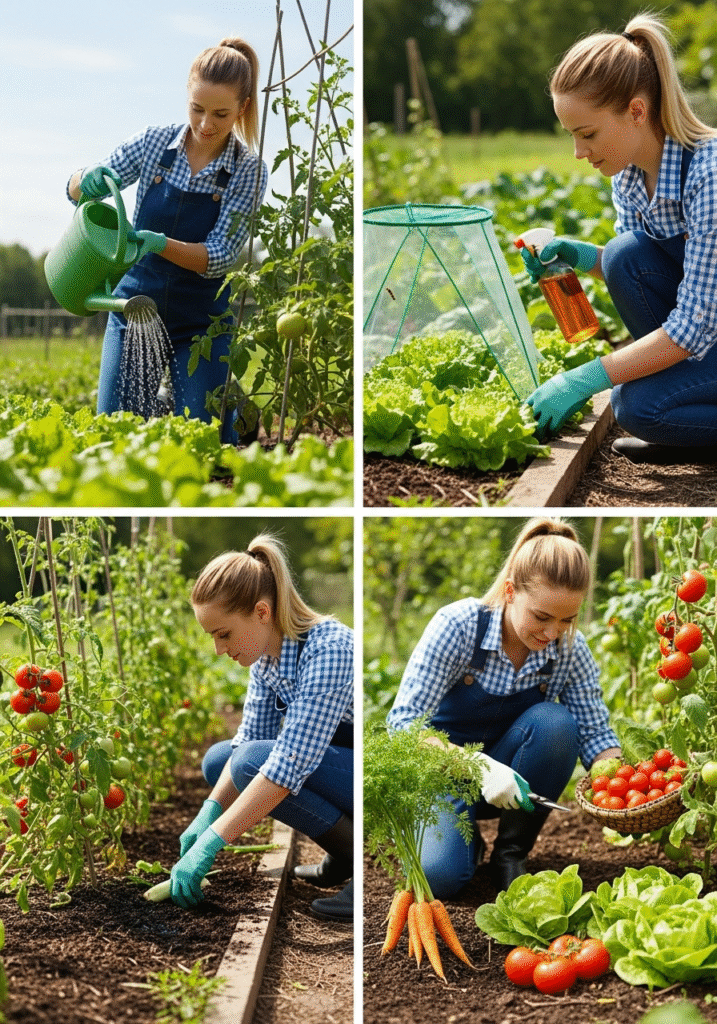
Common Mistakes to Avoid as a Beginner
Common Mistakes to Avoid as a Beginner: Tips for a Thriving Garden
Gardening can be a trial-and-error experience, especially for beginners. While it’s easy to get excited and dive in, it’s equally important to be aware of common mistakes that can sabotage your hard work. Knowing what to avoid will save you time, effort, and frustration—and, ultimately, help you grow a thriving vegetable garden. In this section, we’ll go over some of the most common mistakes new gardeners make, and how to avoid them.
1. Overwatering or Underwatering
Watering is one of the most critical aspects of plant care, but it’s also one of the most common areas where beginners go wrong. Both overwatering and underwatering can cause serious damage to your vegetables.
- Overwatering: It’s easy to assume that plants need a lot of water, but too much water can drown the roots and lead to root rot. Signs of overwatering include yellowing leaves, wilting, or soggy soil that doesn’t drain well. To avoid overwatering:
- Check the moisture level in the soil before watering by sticking your finger about 1–2 inches into the ground. If it feels moist, hold off on watering.
- Ensure proper drainage in containers and garden beds to prevent standing water around the roots.
- Water deeply but less frequently. A few deep waterings per week are better than daily shallow ones.
- Underwatering: On the flip side, insufficient watering can stress plants and stunt their growth. Signs of underwatering include dry, crispy leaves, wilting, and soil that feels hard and dry. To avoid underwatering:
- Water early in the morning to give plants time to absorb moisture before the heat of the day.
- Use mulch to help retain soil moisture and reduce evaporation.
- Check the moisture level regularly, especially during dry spells or if you have particularly thirsty plants like tomatoes and zucchinis.
2. Planting Too Close Together
While it might seem like planting vegetables closely together will maximize your space, it can actually harm your plants in the long run. Crowded plants compete for sunlight, water, and nutrients, leading to stunted growth, poor yields, and a higher likelihood of disease.
- Spacing Matters: Each vegetable variety has specific spacing requirements, and ignoring them can result in weak plants. For example, tomatoes need 18–24 inches between plants, while lettuce can be planted 6–12 inches apart. Refer to seed packets or gardening guides for the recommended spacing for each plant.
- Airflow is Important: When plants are too close together, they don’t get enough airflow, which can create a humid environment where mold, mildew, and other fungal diseases thrive. Proper spacing allows air to circulate around your plants, reducing disease risk and promoting healthy growth.
- Thin Seedlings: If you’ve started your garden from seeds, be sure to thin seedlings once they start sprouting. Remove the weaker or overcrowded plants to give the remaining ones space to grow. This is especially important for crops like carrots, radishes, and leafy greens.
3. Ignoring Pests and Diseases
One of the most discouraging parts of gardening can be the appearance of pests or diseases, but it’s crucial not to ignore these issues. Left unchecked, they can quickly damage your plants and even wipe out an entire crop.
- Pests Are Common: Bugs like aphids, caterpillars, and slugs are common garden pests, and they can wreak havoc on your vegetables. Early intervention is key. Check your plants regularly for signs of pests, such as holes in leaves, discolored spots, or sticky residue.
- Natural Remedies: Instead of resorting to harsh chemicals, try natural pest control methods like introducing beneficial insects (like ladybugs), using neem oil, or spraying your plants with insecticidal soap.
- Remove Pests by Hand: For smaller gardens, handpicking pests off plants can be an effective strategy, especially for larger pests like tomato hornworms or squash bugs.
- Diseases Spread Quickly: Plant diseases, like blight or mildew, can spread quickly through your garden. Regularly inspect plants for signs of disease, such as wilting, browning, or unusual spots.
- Remove Infected Plants: If you spot a plant with disease symptoms, remove it immediately to prevent it from spreading to healthy plants.
- Maintain Cleanliness: Keep your garden free of dead plant material, fallen leaves, and debris that can harbor disease-causing pathogens.
- Rotate Crops: Planting the same crops in the same spot year after year can lead to soil-borne diseases. Try rotating your crops to prevent this and maintain healthier soil.
4. Not Testing Soil Quality
Soil is the foundation of your garden, and without healthy, nutrient-rich soil, your vegetables won’t grow properly. Testing your soil’s pH and nutrient levels is essential, especially for first-time gardeners.
- pH Matters: Different plants thrive in different pH ranges. For instance, tomatoes prefer slightly acidic soil (pH 6.0–6.8), while potatoes prefer neutral soil (pH 6.0–7.0). Testing your soil can help you make adjustments if necessary.
- Add Amendments: Based on soil test results, you may need to amend the soil with organic compost, lime, or sulfur to adjust pH or improve fertility.
- Organic Fertilizers: Rather than using synthetic fertilizers, consider using organic options like compost, aged manure, or organic granular fertilizers that will provide slow-releasing nutrients to your plants.
5. Overcrowding the Garden with Too Many Varieties
New gardeners are often tempted to plant every vegetable they love in a single space, but this can lead to problems. Different vegetables have different needs in terms of sunlight, water, space, and growing seasons. Planting too many varieties in one garden can result in poor growth and a lack of focus on what works best for your space.
- Start Small: It’s tempting to go big, but starting small and focusing on a few varieties of vegetables will give you a better chance for success. Once you gain more experience, you can expand your garden with confidence.
- Plan Your Layout: Plan your garden based on the specific needs of each plant. Group plants with similar water and sunlight requirements together to make care more manageable.
Final Thoughts:
Gardening is a learning experience, and mistakes are part of the process. But by avoiding these common pitfalls—overwatering, overcrowding, neglecting pests, and not testing soil—you’ll set yourself up for a more successful and enjoyable garden. With some patience and attention to detail, you’ll soon be reaping the rewards of your efforts—healthy, fresh, homegrown vegetables.
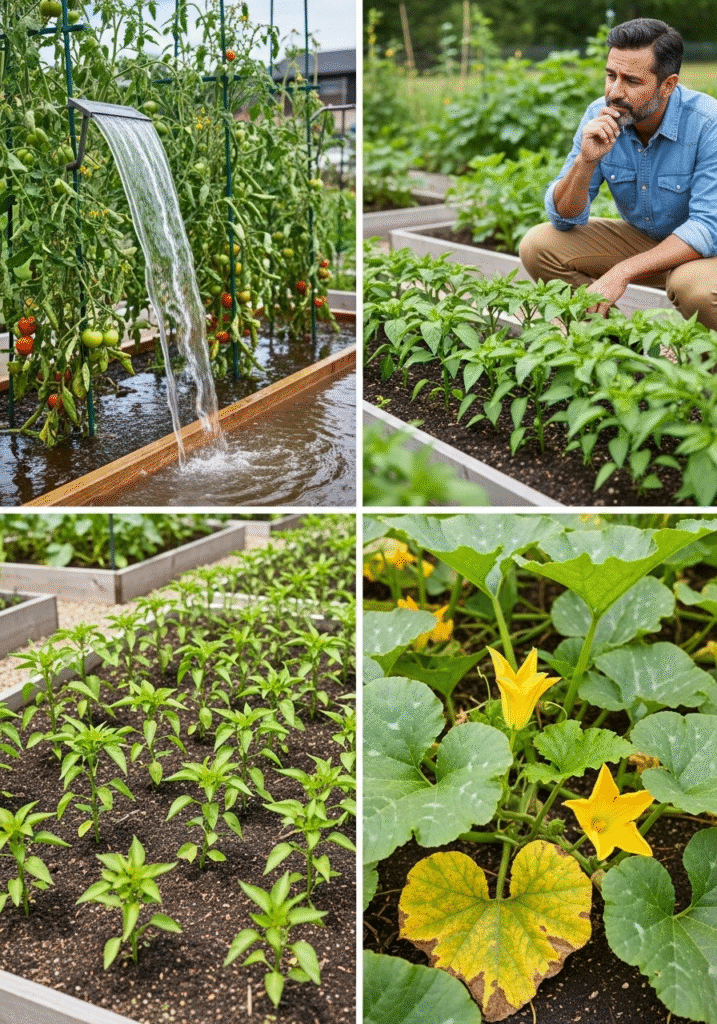
Harvesting and Storing Your Vegetables
The most rewarding part of vegetable gardening is the moment you harvest the fruits (and vegetables) of your labor. Knowing when to harvest and how to properly store your produce can make a huge difference in the flavor, texture, and shelf life of your vegetables. In this section, we’ll walk you through the signs that your vegetables are ready to harvest and provide essential tips for storing them so they stay fresh for as long as possible.
1. Signs Your Vegetables Are Ready to Harvest
Harvesting at the right time ensures that your vegetables are at their peak in terms of flavor, texture, and nutritional value. But how do you know when they’re truly ready to pick? Different vegetables have different indicators for readiness. Here are a few key signs for some popular garden veggies:
- Tomatoes:
- Tomatoes should be fully colored (red, yellow, orange, or whatever their ripe color is) and slightly soft to the touch. Avoid picking them too early—if they’re still hard or green, they won’t have developed their full flavor.
- Tip: If frost is expected, harvest green tomatoes and let them ripen indoors.
- Lettuce:
- Lettuce is ready when the leaves are fully grown and tender. If you’re harvesting whole heads, wait until they’re firm and have a good size. For leafy varieties, pick individual leaves when they’re young and tender for the best taste.
- Tip: If lettuce starts to flower (bolting), the leaves can become bitter—harvest earlier to avoid this.
- Carrots:
- Carrots are ready to harvest when the tops of the roots are thick and the color is rich (usually orange, but they come in purple, red, and yellow too). Pull a few out to check their size—once they reach about 1 inch in diameter, they’re usually ready to pick.
- Tip: Harvesting carrots after a light frost can make them sweeter, as the cold helps break down starches into sugars.
- Zucchini:
- Zucchini should be harvested when they’re 6–8 inches long. At this size, they’re tender and full of flavor. If left too long, they can grow too large and develop a tough, woody texture.
- Tip: Regular harvesting encourages more fruit production, so keep picking them while they’re young.
- Radishes:
- Radishes mature quickly and are usually ready within 3–4 weeks. They’re ready when the roots are firm, crisp, and about 1 inch in diameter. If you leave them too long, they’ll become woody and lose their flavor.
- Tip: Harvest radishes in the morning for the best flavor and texture.
- Spinach:
- Spinach is best harvested when the leaves are young and tender, before they start to bolt. If you wait too long, they can become tough and bitter.
- Tip: Pick the outer leaves first, and let the inner leaves continue growing for an extended harvest.
- Beans and Peas:
- Beans and peas are ready when the pods are full and rounded but before they start to dry out. Check the size and fullness of the pods and pick them before they become too mature.
- Tip: Harvest regularly to encourage more pod production.
- Potatoes:
- Potatoes are ready when the leaves of the plant turn yellow and die back. For “new potatoes,” you can harvest early, when the plant is still flowering, and they’ll be small and tender. For mature potatoes, wait until the plants die completely.
- Tip: Let mature potatoes cure for a few weeks in a dry, dark place before storing for long-term use.
2. Proper Storage Methods to Keep Produce Fresh
Once your vegetables are harvested, proper storage is essential to ensure that they remain fresh and delicious. Different vegetables require different storage methods based on their moisture content and shelf life.
- Tomatoes:
- Storage: Store tomatoes at room temperature, away from direct sunlight. Avoid refrigerating them, as cold temperatures can affect their flavor and texture. Once they ripen, they should be consumed within a few days to a week.
- Tip: If you have an abundance of ripe tomatoes, consider making sauces or canning them for longer-term storage.
- Lettuce and Leafy Greens:
- Storage: Wash and dry lettuce or leafy greens thoroughly before storing them in the fridge. Place them in a produce drawer or in a container with a damp paper towel to keep them crisp.
- Tip: For longer shelf life, store greens in perforated plastic bags to allow airflow, or use a salad spinner to remove excess moisture.
- Carrots:
- Storage: Carrots can be stored in the fridge, ideally in a plastic bag or container with some airflow. Remove any green tops, as they can draw moisture away from the root.
- Tip: Carrots can also be stored in a cool, dark place, like a root cellar, for longer-term storage.
- Zucchini:
- Storage: Zucchini should be stored in the fridge in a perforated plastic bag or vegetable drawer to allow for airflow.
- Tip: Zucchini doesn’t store well for long periods, so it’s best to eat them within a few days. If you have a large harvest, you can also freeze zucchini after blanching it.
- Radishes:
- Storage: Radishes should be stored in the fridge, either in a plastic bag or container with a damp cloth to keep them crisp.
- Tip: If you have an abundance of radishes, you can pickle them to extend their shelf life.
- Beans and Peas:
- Storage: Fresh beans and peas should be stored in the fridge in an airtight container.
- Tip: If you’re not going to eat them within a few days, consider freezing them. Simply blanch the beans or peas before freezing to preserve their flavor and nutrients.
- Potatoes:
- Storage: Store potatoes in a cool, dark, dry place—such as a basement or pantry—at around 45–50°F (7–10°C). Keep them away from onions, as the gases emitted can cause them to spoil faster.
- Tip: Don’t refrigerate potatoes, as cold temperatures can turn their starches into sugars, affecting flavor.
3. Preserving Your Harvest for Long-Term Use
If you’ve grown more vegetables than you can eat at once, there are several ways to preserve your harvest for later use:
- Canning: Vegetables like tomatoes, beans, and cucumbers can be canned in jars and stored for months. Make sure to follow proper canning procedures to avoid contamination and spoilage.
- Freezing: Many vegetables, such as beans, zucchini, and carrots, freeze well after being blanched. Freezing preserves their flavor and nutrients for up to a year.
- Drying: Herbs, tomatoes, and beans can also be dried for long-term storage. Consider investing in a food dehydrator or drying your produce in the sun.
Final Thoughts on Harvesting and Storing
Harvesting and storing vegetables at the right time ensures that your hard work doesn’t go to waste. By recognizing the signs of readiness and following the proper storage techniques, you can extend the life of your garden’s bounty and enjoy fresh, homegrown vegetables throughout the season and beyond. Remember that harvesting regularly encourages further growth, so don’t be afraid to pick your vegetables early and often to keep your garden productive.

Bonus Tips for Urban Gardeners (Small Spaces & Containers)
Urban gardening presents its own unique set of challenges, but it also offers exciting opportunities for creative, space-efficient gardening solutions. Whether you’re dealing with a tiny apartment balcony, a rooftop, or a small patio, you can still grow fresh vegetables with the right techniques. In this section, we’ll share some bonus tips tailored for urban gardeners, helping you make the most of limited space and containers.
1. Balcony or Patio Gardening: Making the Most of Small Spaces
If you’re lucky enough to have a balcony or patio, you’ve got a perfect spot for a compact vegetable garden. Even a small area can become a productive garden with the right approach. Here’s how to maximize the potential of these outdoor spaces:
- Choose the Right Spot: Select a location on your balcony or patio that gets at least 6 hours of sunlight per day. The more sun your plants get, the better they’ll grow. If you don’t have a lot of sunlight, focus on growing leafy greens like lettuce, spinach, and herbs, which thrive in partial shade.
- Use Railings and Walls for Extra Space: Balcony railings and walls provide a great opportunity for creative gardening. Hanging planters or railing boxes are perfect for growing herbs, strawberries, or small vegetables. You can also use a wall-mounted trellis to grow climbing plants like peas, cucumbers, or tomatoes.
- Consider a Garden Trolley: If your balcony or patio has limited permanent space, a movable garden trolley or rolling cart can provide flexibility. You can move the trolley to follow the sun or shift it to protect plants from strong winds or excessive heat.
2. Vertical Gardens: Utilizing Height for a Larger Harvest
Vertical gardening is a game-changer for urban gardeners who need to make the most of limited space. By growing plants upwards, you can maximize the area you have and grow more with less. Here’s how you can take advantage of vertical gardening in small spaces:
- Use Trellises and Arches: A trellis is an essential tool for growing climbing vegetables like tomatoes, cucumbers, beans, and peas. Position a trellis along a wall or against a balcony railing to let these plants grow upwards, saving precious floor space.
- Vertical Planters and Towers: Vertical planters or towers are specialized containers designed to hold several plants in stacked tiers. These are perfect for small spaces, as they allow you to grow a variety of vegetables, such as lettuce, herbs, and even small fruiting plants like strawberries. Many vertical planters come with built-in irrigation systems, which makes them low-maintenance options.
- Hanging Baskets: Hanging baskets aren’t just for flowers—they can be used to grow vegetables as well. Hanging tomatoes, peppers, or herbs in baskets can free up floor space while giving your plants ample sunlight. Ensure that the baskets are large enough to allow the roots to spread, and check for proper drainage.
- Wall Planters or Pocket Gardens: Wall-mounted pocket planters are perfect for growing shallow-rooted plants like herbs, lettuce, and spinach. These can be hung against any vertical surface and are an excellent option for balconies, patios, or even the side of a fence.
3. Best Container-Friendly Vegetables for Small Spaces
Container gardening is an ideal way to grow vegetables when you’re working with limited space. Many vegetables thrive in containers, as long as they’re given the right conditions. Here’s a list of the best vegetables for growing in containers:
- Lettuce and Other Leafy Greens: Lettuce, spinach, kale, and arugula grow well in containers and are perfect for beginners. They don’t need deep soil, and you can grow them in shallow pots or even window boxes. Plus, these leafy greens grow quickly and can be harvested multiple times throughout the season.
- Herbs: Herbs like basil, parsley, cilantro, mint, and thyme thrive in containers and are perfect for growing on a balcony or patio. These plants don’t need a lot of space to grow and can be grown in small pots or hanging baskets.
- Radishes: Radishes are compact and fast-growing, making them perfect for containers. They don’t require a lot of space for their roots to spread, so a medium-sized pot is enough to grow a good crop.
- Tomatoes: While larger tomato varieties may need bigger containers, cherry and dwarf tomato varieties are excellent choices for small spaces. Look for determinate varieties (which grow to a certain height and stop) as they tend to perform better in containers.
- Peppers: Peppers, both sweet and hot, can be grown successfully in containers. Choose smaller or dwarf varieties that are better suited to pots. They require full sun, so make sure to place them in a sunny spot.
- Carrots: Compact varieties of carrots, such as ‘Thumbelina’ or ‘Parisian’, are ideal for container gardening. Use deep containers to allow the roots to grow, but carrots don’t need a lot of space in terms of width.
- Zucchini (Dwarf Varieties): While regular zucchini needs more space, dwarf varieties can be successfully grown in containers. Just be sure to give them a large enough pot (at least 18 inches wide) and a sunny location.
4. Tips for Successful Urban Gardening
To ensure that your urban garden thrives, keep these additional tips in mind:
- Use Good Quality Soil: Since you’re growing in containers, it’s crucial to use high-quality potting mix rather than regular garden soil. Potting mix is lightweight and well-draining, which is ideal for container gardening. Consider adding organic compost to enrich the soil.
- Watering is Key: Container plants dry out faster than those in the ground, so be prepared to water regularly. Check the soil moisture level daily, and water when the top inch of soil feels dry. Consider investing in self-watering containers to make watering more convenient.
- Fertilize Regularly: Vegetables in containers often need more nutrients than those grown in the ground. Use a balanced liquid fertilizer or organic compost to feed your plants every couple of weeks, especially during their active growing season.
- Mind the Temperature: Urban environments can get quite hot, especially in cities with lots of concrete. Consider placing your containers in a location that receives some afternoon shade to protect your plants from extreme heat.
- Rotate Crops: Even in small spaces, try to rotate your crops to prevent soil depletion. After one crop is finished, replace it with a different type of plant to ensure the soil stays healthy.
Final Thoughts for Urban Gardeners
Urban gardening doesn’t require a sprawling backyard to grow your own fresh vegetables. With a little creativity, you can turn a balcony, patio, or even an empty corner into a productive garden. By using vertical gardening techniques, selecting container-friendly vegetables, and optimizing your small space, you can enjoy the many benefits of homegrown produce, even in the heart of the city. So, get started today and transform your urban space into your very own green oasis!
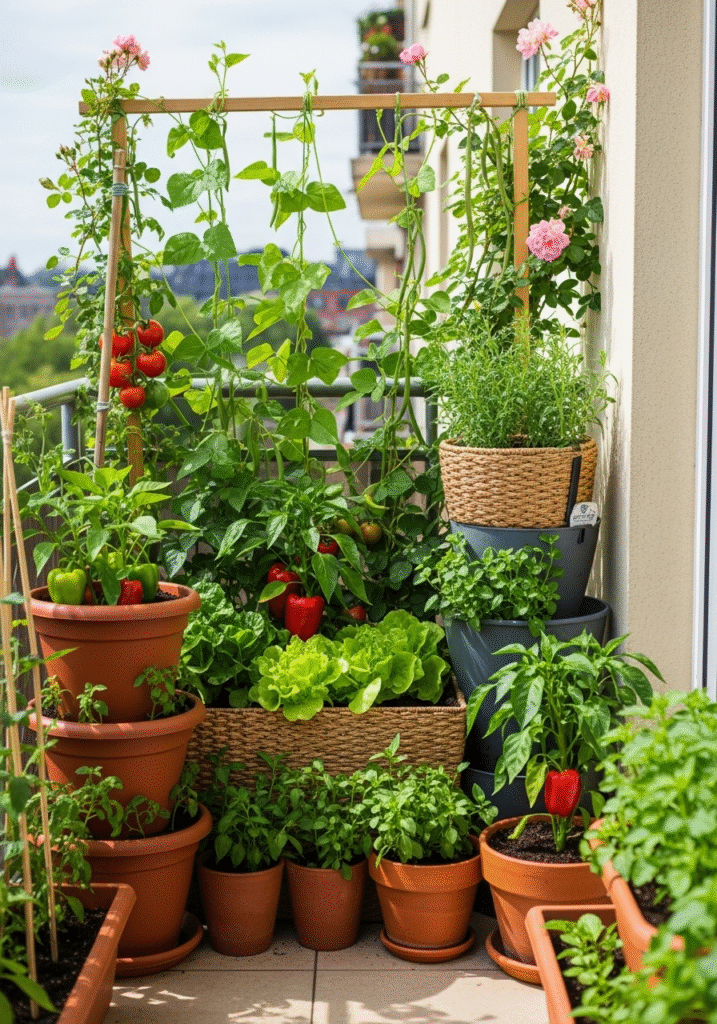
Conclusion
Starting a vegetable garden is one of the most rewarding and fulfilling experiences you can embark on. Whether you’re a complete beginner or someone with just a bit of gardening knowledge, there’s no better time than now to begin cultivating your own food. It doesn’t matter if you have a spacious backyard or a small balcony—you can grow fresh, delicious vegetables in almost any space. The key is to start small and take it one step at a time.
Start Small, Grow Big
As with any new skill, it’s important to ease into vegetable gardening. Don’t overwhelm yourself with too many varieties or a massive plot right away. Begin with a small space—perhaps a couple of containers or a small raised bed—and focus on a few easy-to-grow vegetables. Once you gain confidence, you can expand your garden year after year, trying new plants and perfecting your technique. Gardening is a journey, and every step you take will deepen your connection with nature and your food.
The Incredible Benefits of Gardening
Health Benefits: Gardening provides not only fresh, organic food but also an opportunity to connect with the outdoors and get some exercise. There’s nothing more satisfying than harvesting and eating vegetables that you’ve grown yourself. The act of gardening also lowers stress levels, boosts mental health, and can even improve your mood through the release of endorphins as you work with the soil.
Cost Savings: By growing your own vegetables, you can save money on your grocery bill. A small garden can provide you with a steady supply of fresh produce, especially if you focus on high-yield crops like tomatoes, lettuce, and beans. Over time, the savings can add up significantly, making your gardening efforts both cost-effective and rewarding.
Environmental Benefits: Homegrown vegetables come with a lower environmental footprint than store-bought produce. When you grow your own food, you reduce the need for transportation, packaging, and synthetic pesticides, which all contribute to environmental harm. Additionally, gardening helps promote biodiversity, enriches soil health, and supports pollinators like bees and butterflies.
Your Gardening Journey Begins Now
The journey to becoming a vegetable gardener doesn’t have to be complicated or daunting. It all starts with a single seed, a small plot, and the willingness to learn. Whether you’re growing tomatoes on your windowsill or a full-fledged vegetable garden in your backyard, you’re taking a step toward a healthier, more sustainable, and more rewarding lifestyle.
So, why wait? Start your first vegetable garden today! Begin with a simple, easy-to-grow vegetable—maybe some leafy greens or herbs—and watch your gardening skills blossom. As you nurture your plants, you’ll be rewarded not only with fresh produce but also with a sense of accomplishment and joy. There’s no better time to start than now, and your future self will thank you for taking that first step.
Call to Action: Don’t wait for the perfect moment—get started on your vegetable garden today! Gather your tools, pick your first plants, and dive into the world of gardening. The rewards are endless, and the satisfaction of growing your own food is well worth the effort. Happy gardening!
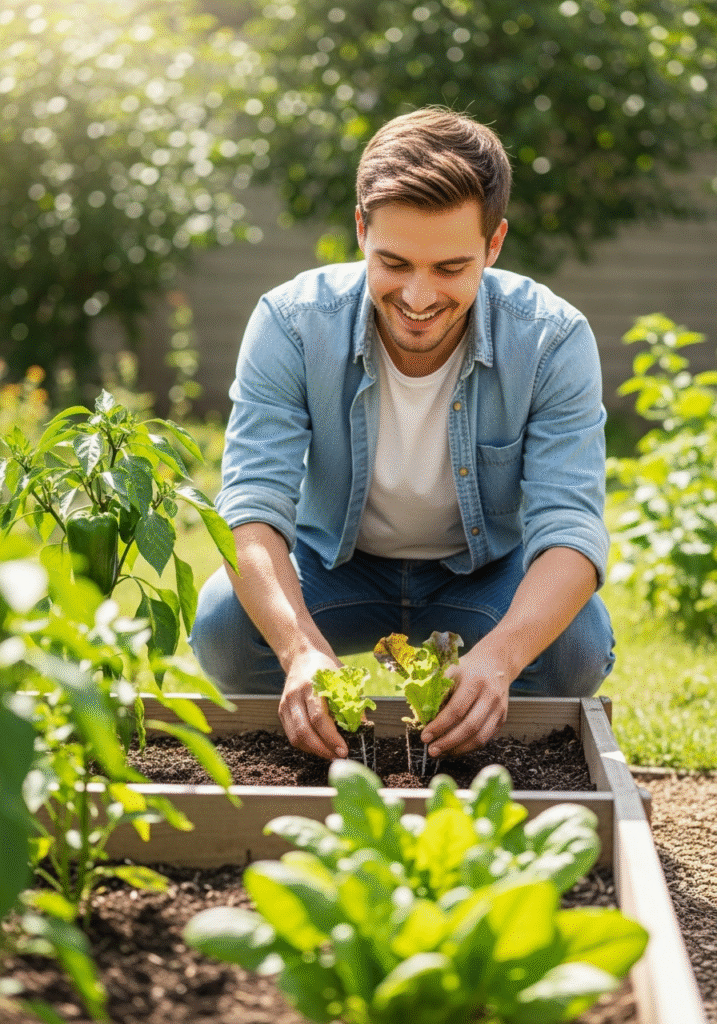

Pingback: Top 10 Air Purifying Plants to Refresh Your Home Naturally - pademoluxury.com